The development of THz devices, operating at fiber optic wavelengths, could soon cover the last available part of the spectrum — millimeter/submillimeter frequencies — tackling the problem of bandwidth requirements for mobile end-user connectivity.
GUILLAUME DUCOURNAU, INSTITUTE OF ELECTRONICS, MICROELECTRONICS AND NANO-TECHNOLOGY, LILLE UNIVERSITY OF SCIENCE AND TECHNOLOGY
With the massive development of optical networks in the past 10 years, optical data rates have now reached several hundred gigabits per second (Gbps) in standard configurations of advanced signal encoding. In parallel, wireless networks are now reaching the limits of available bandwidth. Within the next decade, these networks are expected to use new spectrum resources. In particular, THz photonics devices, acting as direct transceivers between the optical world and the radio world, could take advantage of already deployed optical networks to cover cellular backhaul, and deliver high data rates to mobile end users.
With the exponential increase in data traffic, network capacity requirements have driven major physical layer technical evolutions, as in optical core networks, wirelines and cellular. As an example, internet protocol traffic is still expected to grow beyond 130 exabytes per month by 2018. At the same time, the massive use of mobile connection is pushing the need for wide bandwidth delivered up to the end users in a wireless regime. However, wireless radio links — access/fronthaul or backhaul — must increase in capacity to handle these future dataflows, as available frequency bands are almost fully allocated and used. In this context, it is anticipated that by 2020, THz or sub-THz spectrum (beyond 200 GHz) will be explored for the use of ultrafast wireless communications. Indeed, the data traffic increase is mainly on a wireless channel1.
Since the first microwave wireless link was developed by Guglielmo Marconi in the early 20th century, the carrier frequency used for wireless communications has been continuously increased2 to meet the ever-increasing system requirements for high data rate, up to the recently available frequency bands in millimeter-wave frequencies of 60 GHz, 70 GHz and about 95 GHz. Due to the fact that the allocated bandwidth is less than 10 GHz per band, future end-user needs (nomadic usages) are difficult to cover with allocated bandwidths. To further increase available data rate and bandwidth, the THz range has to be used; in the last decade there has been a huge pressure to push the development of these systems, expecting the use of the THz frequencies by 2020.
Therefore, over the past 10 years many developments have been made to prepare for the future convergence between fiber optic and mobile end users, in backhaul — point-to-point (P2P) — or fronthaul schemes. Both require very high frequency transceivers, and electronic/optic approaches are under investigation. In addition, the massive development of multilevel encoding combined with standard WDM (wavelength division multiplexing) and the context of coherent networks and core signal processing is now established. Thus, the quest for direct optical-to-radio transceivers has become very attractive and would enable direct bridges between optical data rates and mobile data delivery. These new spectrum resources, localized at the millimeter/submillimeter frontier due to atmospheric response suitable window (Figure 1), are, up to now, not regulated.
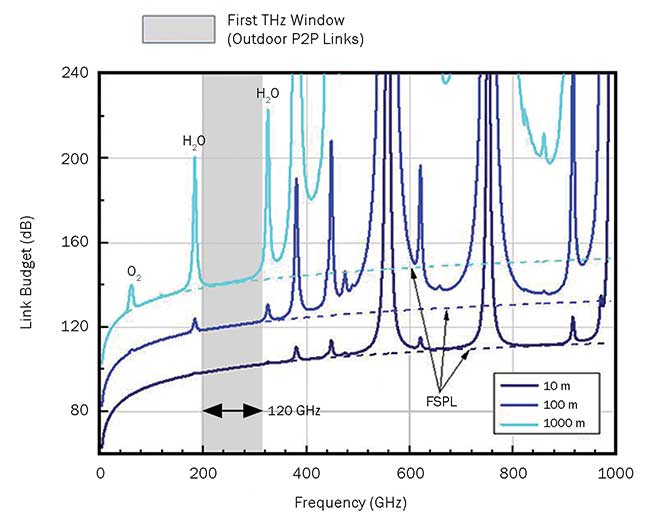
Figure 1. THz potential frequency bands. (FSPL = free space path loss; P2P= point-to-point). Courtesy of Guillaume Ducournau/IEMN.
In the more general context of communication systems, two key main figures are the data rate and the distance covered by the link. The data rate is ultimately determined by Shannon’s formula; that is, the capacity is given by:
C(bit/s) = B.log2 (1+S/N)
High data rate wireless systems using THz frequencies could be possible due to the large available bandwidth (B). However, the S/N ratio is the main limiting factor of THz systems as the power level tends to decrease with the carrier frequency.
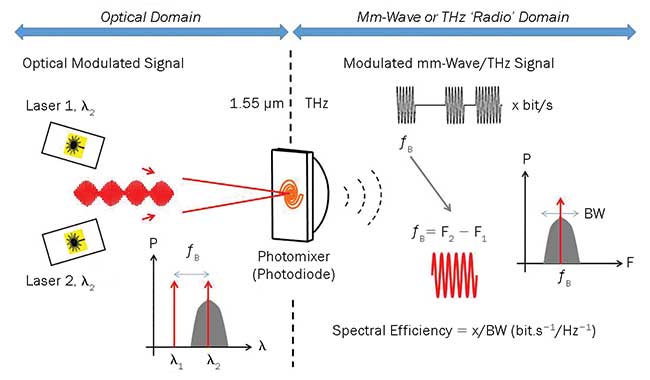
Figure 2. The photomixing principle for conversion of optical signal to millimeter/THz radio. Courtesy of Guillaume Ducournau/IEMN.
Current key developments toward the emergence of such services based on optical network existing architecture are expected to cover new millimeter/THz radio access. The basic configuration of these systems relies on the photomixing principle (Figure 2), where a dual wavelength signal — consisting of a modulated optical signal and a pilot carrier — is injected inside a wide bandwidth photodiode to produce a millimeter-wave modulated signal. In order to address potential frequencies beyond 200 GHz, uni-traveling carrier (very high bandwidth as only electrons limit dynamic in the device) photodiodes, initially introduced by Nippon Telegraph and Telephone (NTT) in Japan for optical communications3, then used in THz4, have been used to demonstrate the first presenters in several labs5,6,7.
In this context, photonics-based technology can offer direct down-conversion to the optical signal channel, as a specific carrier frequency in radio domain can be kept constant by changing the optical pilot line (Figure 3).
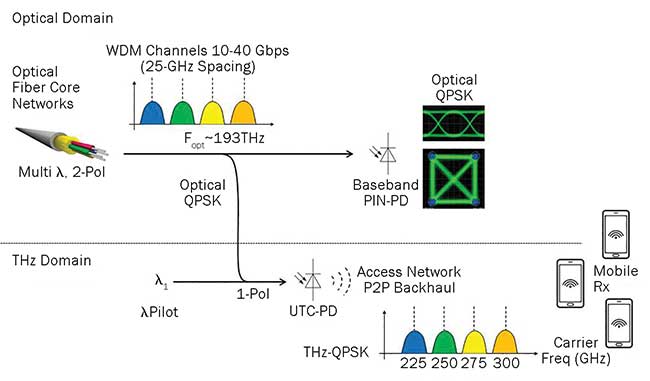
Figure 3. Optical transceiver for down-conversion (optical domain/THz domain) using photomixing (QPSK = quadrature phase shift keying; UTC-PD = uni-traveling-carrier photodiode). Courtesy of Guillaume Ducournau/IEMN.
To address agile radio networks, multicarrier operation and dynamic reconfigurations, photonics-based technologies are very convenient due to their unique bandwidth feature and ability to handle multicarrier and multiformat THz channels (for example, in indoor cases [see Figure 4]), which has no equivalent in electronics-based solutions. This is in phase with optical network evolution toward “flexgrids”8 that will expand core networks’ bandwidth beyond traditional wavelength-division multiplex systems.
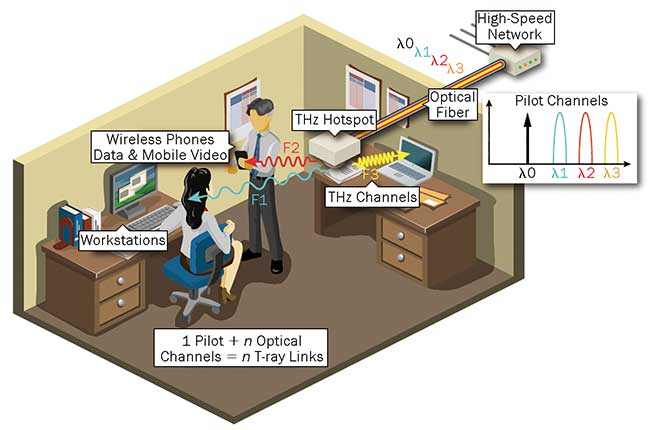
Figure 4. An artist rendering of the passive THz hotspot used for indoor optical-to-THz convergence. Shown here, a single optical pilot λ0 can be added to the existing networks working in WDM (wavelength division multiplexing) to relay existing high-speed optical data from fiber (λ1, λ2, λ3) to wireless at multiple THz frequencies (F1, F2, F3). As THz systems are expected to operate in a line of sight configuration, this schematic view illustrates the possible point-to-point high data rates links. Courtesy of SEMM Service, Yannick Bonnaz/University of Lille 1 and Guillaume Ducournau/IEMN.
Beyond Shannon capacities, the main figure of merit of a communication system is the product data-rate distance (PDD) in Gb/s-1 · km that can be covered by real-time working systems. Actually, the highest reported real-time PDD is for a 120-GHz system by NTT in Japan is 10 Gb/s-1 · km9, using amplitude shift keying (ASK) in a real-time kilometer-range link. No other group in the world, to our knowledge, has reported such performance in the sub-THz range. Several “first-age” THz wireless systems have been reported; Figure 510,11,12,13,14 demonstrates some performances over the last 10 years. A lab demonstration of a QAM-16 32-Gbps THz link is shown in Figure 6.
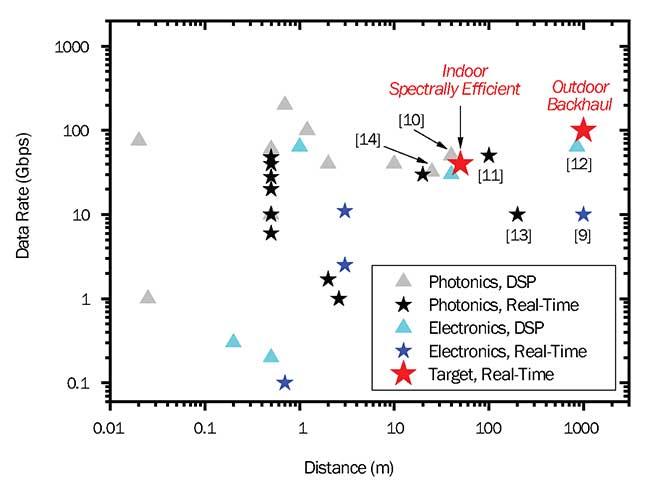
Figure 5. Several reported performances of THz wireless links. Courtesy of Guillaume Ducournau/IEMN.
One key aspect for THz systems will be to establish suitable technology to address required power for backhaul/fixed links and beam-forming antennas for mobile accesses, with at least the Rx being mobile. There is still a clear need for amplification at both the emitter and receiver, and first mm-wave/THz monolothic microwave integrated circuits (MMICs) are now demonstrated. However, beyond these first developments, THz amplifiers for both transmitters and receivers have become key enabling technology. An example of such progress is a THz amplifier based on InP HBTs with a record high bandwidth of 235 GHz15. Future development may use advanced CMOS for massive advances in the lower THz band, i.e., in the 100- to 300-GHz range. In addition, promising powerful traveling wave tube (TWT) structures for long distance links will increase the signal (carrier)-to-noise ratio (S/N) by several orders of magnitude.
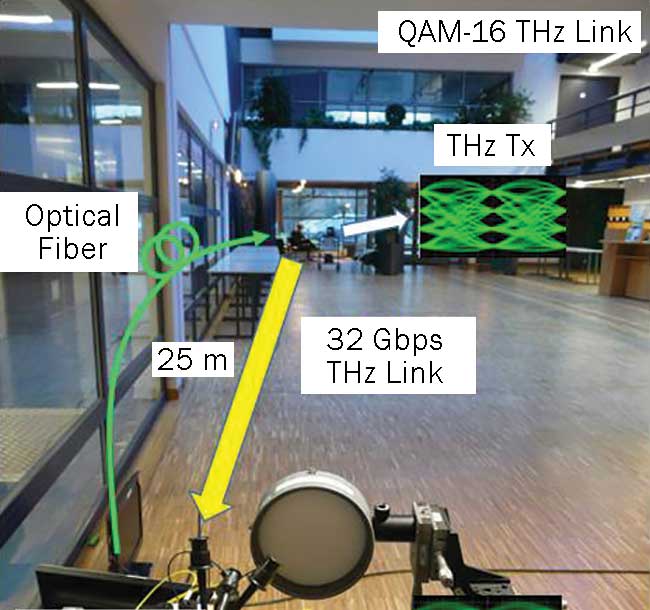
Figure 6. A 25-m/32-Gbps THz transmission system. Courtesy of Guillaume Ducournau/IEMN.
For nomadic usages, development of silicon-based photonics and/or CMOS might enable advanced integration and miniaturization, which is especially required for mass market applications, such as those embedded in mobile terminals. Also, it is worth mentioning that energy aspects must also be considered to ensure a low required number of energy per bit. To reach this, a simple modulation format may be used for short links dedicated to each user to release technical requirements on digital signal processing at receiver side. On the contrary, P2P high data rate links (backhaul) may not be limited by this issue, as hardware will rely on a fixed infrastructure, thus reducing energy constraints. Subsystems are interconnects that can also be developed in this frequency range; for example, reconfigurable and efficient antennas for low-cost mobile apps.
Many other challenges and issues are coming to the forefront in this new frequency range: It is clear that targeted data rates for P2P links should be n * 100 Gbps, in many bands, for kilometer-range links. Even if III-V electronic and photonic devices have driven and continue to drive maximum reported performance, a mixture of technologies including silicon photonics may arise in the coming years, and co-integration with specific subsystems and packaging approaches might be considered. Standardization is also now on the road by work initiated in the IEEE 802.15 working group for wireless personal area networks (WPANs)16.
Meet the author
Guillaume Ducournau is an associate professor with the Institute of Electronics, Microelectronics and Nanotechnology’s THz Photonics Research Group at Lille University of Science and Technology in Villeneuve-d’Ascq, France. His work focuses on THz devices and measurement setups, as well as quasi-optics measurements and THz communications; email: [email protected]
lille1.fr.
Acknowledgments
Guillaume Ducournau gratefully acknowledges the Agence Nationale de la Recherche (ANR) for funding the COM’TONIQ ‘Infra’ 2013 program on THz communications, through the grant ANR-13-INFR-0011-01, and the support from several French research programs and institutes — Lille University, IEMN institute (RF/MEMS Characterization Center, Nanofab and Telecom platform), IRCICA institute (USR CNRS 3380), the CNRS and by the RENATECH network. This work was also supported in part by the French Programmes d’investissement d’avenir Equipex FLUX 0017, ExCELSiOR project and the Nord-Pas de Calais Regional council, and the FEDER through the CPER Photonics for Society. Some of the work was also supported by an IEMN-Lille University-Tektronix academic-industrial partnership on THz communications.
References
1. Cisco Systems Inc. (June 2014). The zettabyte era: trends and analysis. Cisco Visual Networking Index, pp. 1-24.
2. M. Pagani and H. Italia (2015). Microwave digital radio link transceivers: Historical aspects and trends. IEEE Int Microwave Symp Workshop WMH-2.
3. T. Ishibashi and S. Kodama, et al. (1997). High-speed response of uni-traveling-carrier photodiodes. JJAP, Vol. 36, Issue 10, pp. 6263–6268.
4. T. Ishibashi and Y. Muramoto, et al. (Nov.-Dec. 2014). Unitraveling-carrier photodiodes for terahertz applications. IEEE J Sel Top Quantum Electron, Vol. 20, Issue 6, pp. 79-88, doi: 10.1109/JSTQE.2014.2336537.
5. T. Nagatsuma and S. Horiguchi, et al. (2013). Terahertz wireless communications based on photonics technologies. Opt Express, Vol. 21, Issue 20, pp. 23736–23747.
6. H. Shams and M.J. Fice, et al. (2014). Photonic generation for multichannel THz wireless communication. Opt Express, Vol. 22, Issue 19, p. 23465.
7. G. Ducournau and P. Szriftgiser, et al. (2014). Ultrawide-bandwidth single-channel 0.4-THz wireless link combining broadband quasi-optic photomixer and coherent detection. IEEE Trans Terahertz Sci Technol, Vol. 4, Issue 3, pp. 328–337.
8. G. Bennett and S. Melle (2013). Superchannels, flex-grid, multilayer switching key developments for next-gen transport networks. Lightwave, http://go.nature.com/7EISV5.
9. A. Hirata, et al., (2012). 120-GHz-band wireless link technologies for outdoor 10-Gbit/s data transmission. IEEE Trans Microw Theory Tech, Vol. 60, Issue 3, pp. 881-895.
10. S. Koenig and D. Lopez-Diaz et al. (2013). Wireless sub-THz communication system with high data rate. Nat Photonics, Vol. 7, pp. 977-981. doi:10.1038/nphoton.2013.275.
11. T. Nagatsuma and G. Ducournau, et al. (2016). Advances in terahertz communications accelerated by photonics, Nat Photonics, Vol. 10, pp. 371–379, doi:10.1038/nphoton.2016.65.
12. I. Kallfass and F. Boes, et al. (2015). 64 Gbit/s Transmission over 850 m fixed wireless link at 240 GHz carrier frequency. J Infrared Milli Terahz Waves, Vol. 36, pp. 221-233.
13. A. Hirata and T. Kosugi, et al. (2006). 120-GHz-band millimeter-wave photonic wireless link for 10-Gb/s data transmission. IEEE Trans Microw Theory Tech, Vol. 54, Issue 5.
14. G. Ducournau and K. Engenhardt, et al. (2015). 32 Gbit/s QPSK transmission at 385 GHz using coherent ?bre-optic technologies and THz double heterodyne detection. Electron Lett, Vol. 51, Issue 12, pp. 915-917.
15. K. Eriksson and I. Darwazeh, et al. (2015). InP DHBT distributed amplifiers with up to 235-GHz bandwidth. IEEE Trans Microw Theory Tech, Vol. 63, pp. 1334–1341.
16. T. Kuerner (2013). https://mentor.ieee.org/802.15/dcn/13/15-13-0130-01-0thz-launching-a-study-groupon-thz.pdf.